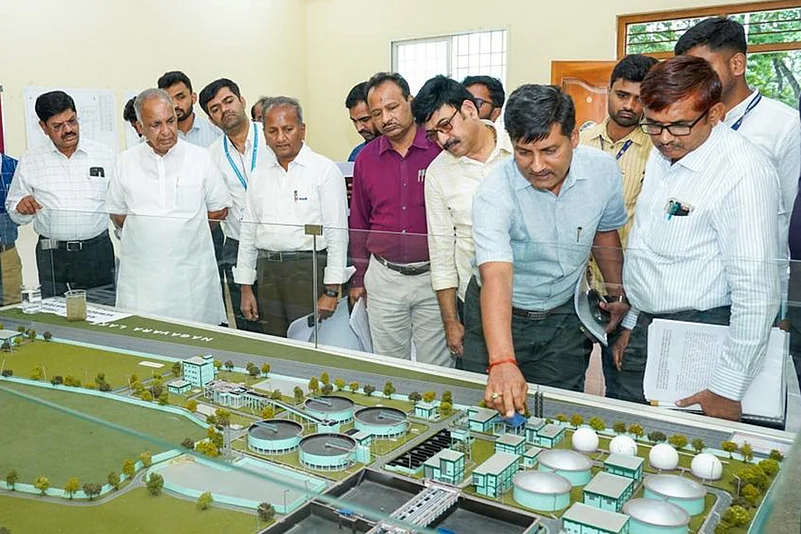In an era of escalating climate uncertainties and water scarcity, Karnataka is demonstrating how a progressive circular economy approach can transform waste into a sustainable resource. The state’s pioneering sewage water treatment and reuse initiative—most notably in the Koramangala-Chellaghatta, Hebal Nagavara, and upcoming Vrishabhavati Valleys—offers a replicable model of resource regeneration, ecological balance, and socio-economic upliftment.
Rethinking Wastewater in a Circular Economy
The concept of circularity reimagines waste not as a by-product to be discarded but as a valuable resource. Karnataka’s large-scale wastewater reuse initiative exemplifies this, aligning with the core tenets of the circular economy: regenerating natural systems, circulating materials, and eliminating pollution. In doing so, the project supports United Nations Sustainable Development Goal 6 (clean water and sanitation), particularly in semi-arid and drought-prone areas.
The cornerstone of this strategy is the RRR principle: Reuse, Recharge, and Restore. Here, sewage water generated in Bengaluru is scientifically treated and diverted to replenish groundwater in neighbouring districts such as Kolar, Chikkaballapura, Bangalore Rural, and Tumkur. The treated water is not only reused but also actively recharges local aquifers, restoring groundwater levels that had plummeted due to over-extraction and declining rainfall.
A Regional Turnaround: Waste to Wealth
Currently, Bengaluru produces around 2,255 million litres of sewage per day (MLD). Of this, 1,349 MLD is treated, and approximately 650 MLD is supplied to the Minor Irrigation Department for ecological reuse. Instead of polluting rivers and reservoirs, Karnataka uses this treated water to replenish 666 lakes across multiple districts. This innovative effort has transformed environmental liabilities into ecological assets.
"This project greatly benefitted our district by significantly enhancing groundwater levels, which has led to an increase in cropping cycles," said M. Byrareddy, Vice President of the Kolar District Raitha Sangha. "The agricultural profile of the district has been entirely transformed by the positive socio-economic impact of these projects.”
Political Will and Administrative Drive
The roots of this sustainable initiative go back to the Siddaramaiah administration (2013–2018), which demonstrated political foresight by initiating one of the country's largest sewage treatment and groundwater recharge projects. Today, Minister N.S. Boseraju, under the current Congress government, is spearheading its expansion.
“The three valley projects we have taken up are not only environmental friendly but also viable, firstly, the carried aspects of these projects will enliven the waterbodies, riverine systems, and also give us enough additional water to fill up tanks in the vicinity that can be used for farming and irrigation to grow vegetables, which will give additional income source to the villages around the valleys of all three projects. Karnataka has 36,568 inland water bodies in total. It is critical to conserve and address the growing crisis in the long-term management of these water bodies. Chief Minister Siddaramaiah, who also holds the finance portfolio has encouraged minor irrigation department’s initiatives while the deputy chief minister D.K. Shivakumar, is paving the way for sustainable impact,” Boseraju said. “Karnataka is the leading state in the implementation of this eco-friendly project and serves as an example for other states.”
The soon-to-be-launched V-Valley project is poised to extend this impact even further. The department is currently evaluating the implementation of this concept in other metropolitan areas across Karnataka beyond Bengaluru. Minister N.S. Boseraju, who has been instrumental in driving the expansion of such initiatives, deserves special commendation for his leadership and vision. The V-Valley project and the broader plans for metropolitan expansion are a direct result of his commitment to strengthening irrigation infrastructure across the state.
Environmental and Economic Outcomes
The results of these initiatives are both visible and measurable. Groundwater recharge has improved remarkably: in specific boreholes, levels rose from 18 to 7.5 metres below ground level (mbgl) in North Bangalore, and from 33 to 9 mbgl in Kolar between March and September 2018—a 58% and 73% improvement, respectively. These changes signify a rapid recovery of groundwater storage, directly linked to the recycling and redirection of treated sewage water.
In environmental terms, lakes now serve as percolation tanks, recharging underground aquifers and restoring ecological stability. Treated water also supports aquatic ecosystems by avoiding the release of pollutants into rivers and coastal zones.
"This project exemplifies the circular economy, transforming sewage into a resource," said Professor Lakshminarayana Rao, Associate Professor at the Indian Institute of Science (IISc), Bangalore. “Karnataka is leading the country in wastewater reuse for indirect groundwater recharge. With the V-Valley project, the state could lead not just India, but Asia in this field.”
Social and Agricultural Transformation
The social narrative is equally compelling. These projects have empowered women and youth by facilitating employment in agriculture, construction, and maintenance sectors. Revived groundwater availability has led to year-round irrigation, which in turn has improved food security and community resilience.
Agricultural output has surged. In post-recycling areas, fish production rose by 133%, land prices increased by 118%, and farmers' net incomes from flower and vegetable farming jumped by 202% and 150%, respectively. Crop yields also improved: flowers by 80%, vegetables by 70%, fruits by 35%, and spices by 28%. Even cereals and oilseeds saw gains of 11% and 7%.
The livestock sector, too, expanded. The number of cattle rose by 37%, and buffaloes saw similar growth. Other livestock such as pigs, sheep, goats, and poultry grew by 100%, 37%, 33%, and 27%, respectively.
Academic and Global Recognition
This model of sustainable water reuse has drawn interest far beyond India. Students and researchers from the United States, Canada, and Germany, along with delegations from the Ministry of Jal Shakti, NITI Aayog, and several Members of Parliament, have visited project sites. All have acknowledged Karnataka’s Department of Minor Irrigation for implementing what is now Asia’s largest sewage water treatment and reuse system.
Karnataka’s sewage water treatment and reuse programme is not just about technology—it is about vision, community, and sustainable transformation. With continued political commitment, scientific collaboration, and public support, this model can inspire similar efforts across India and beyond, making wastewater a cornerstone of water security.
























